Web UI User Guide
Getting started with the Orka UI is quick, simple, and straightforward. Learn how to quickly get set up for the first time, basic operations, and how to get help.
Quick navigation
Time to read: 8 minutes, 38 seconds
Jump to: 1. Before you begin | 2. Authenticate with the cluster] | 3. Launch the Orka UI | 4. Create and deploy your first VM instance | 5. Experience your VM instance | 6. Create a new base image | 7. Time to say goodbye
The ultimate quick start
If you want to skip the detailed explanations, just run through these steps on your own:
- Obtain an authentication token.
- Launch the Orka UI in your browser at
<ORKA_API_URL>.- Go to Nodes.
- Go to Images.
- Go to VM Configs and click Create config (
ghcr.io/macstadium/orka-images/sequoia:latestfor image, 3 for CPU and vCPU, leave VNC enabled).- Click Deploy Config and wait for the confirmation.
- Go to VMs and check the connection information for the instance.
- Use Apple Screen Sharing to connect to the VM instance. Example:
vnc://<VM-IP>:<Screenshare-port>with the IP and port from Step 7. Use theadmin/admincredentials.- Once you login be sure to change the login credentials, apply the latest OS updates, and install (or upgrade) the Orka VM Tools for added security and functionality.
- Return to the UI. On the VMs page, select your VM instance and click More > Save as new image at the top.
- Return to the UI. Go to the Images page and make sure that your new image appears in the list.
- On the VMs page, select your VM instance and click More > Delete at the top.
- Make sure that the list of VMs is empty.
- Go to VM configs and verify that your template is preserved.
The Orka UI is a user-friendly way to get started with Orka. It provides basic capabilities and a clean UI.
The Orka UI will be most beneficial to:
- Beginner users.
- Users with predominantly manual workflows.
1. Before you begin
- Ensure you can access your cluster account in the MacStadium Customer Portal. See Cluster Access Management: Overview.
- Get your VPN connection information from your IP Plan. You can download it from the MacStadium portal.
- Connect to your Orka cluster via VPN.
- Download and install a VPN client. Note that you might need to make additional configuration changes if you're using a custom Orka domain.
- Use the server address and credentials from the VPN section at the top of your IP Plan.
2. Authenticate with the cluster
The Orka Web UI currently does not let you log in with your MacStadium Customer Portal credentials. Instead, you need to obtain an authentication token from the Orka3 CLI.
Orka lets you log in with your MacStadium Customer Portal credentials. Your access privileges are based on the role configured by your account admin in the Customer Portal. By default, you will have access to the orka-default namespace. You can access additional namespaces if you have been added to additional role bindings.
Glossary: Namespace
A way to isolate and dedicate resources to users and teams within the cluster.
The resources within a namespace are completely isolated from one another and cannot be shared between namespaces. By default, users and service accounts limited to a specific namespace cannot access the resources in other namespaces, unless added to the respective role bindings.
orka3 login
Orka will launch a new browser tab (or window) and let you log in via the SSO-enabled form. After you log in, you can return to the command line and run additional orka3 commands. Your token is stored locally in the ~/.kube/config file. Note that your token has a validity duration of one hour. Afterward, you must obtain and pass a new token in your CLI or API calls.
You now need to get your Orka authentication token from your ~/.kube/config:
orka3 user get-token
3. Launch the Orka UI
- In your browser, navigate to your Orka API URL.
What's your Orka API URL?
You can get your Orka API URL from your IP Plan:
- For clusters deployed before Orka 2.1, it's the
.100address for yourPrivate-1network (usually,10.221.188.100), prefixed withhttp. For example:http://10.221.188.100.- For clusters deployed with Orka 2.1 or later, it's the
.20address for yourPrivate-1network (usually10.221.188.20). prefixed withhttp. For example:http://10.221.188.20.- You can also use
https://<orka-domain>andhttps://<custom-domain>(if configured). To get the Orka domain for your Orka cluster, contact MacStadium. To use an external custom domain, see here.Note that you can use
http://<orka-IP>,https://<orka-domain>, andhttps://<custom-domain>interchangeably in your workflows.
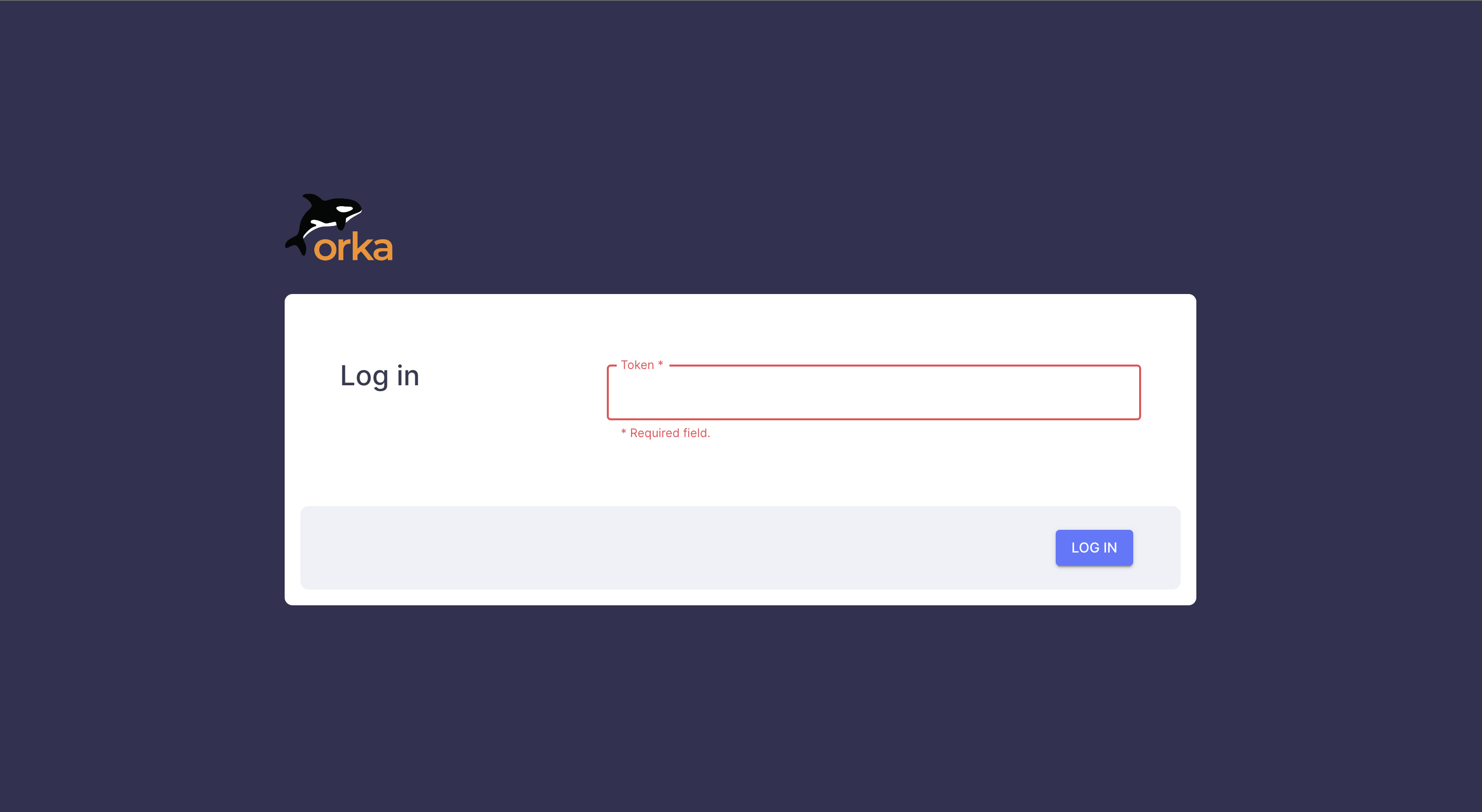
4. Create and deploy your first VM instance
Known limitations
The Orka Web UI works only in the
orka-defaultnamespace.The Orka Web UI does not let you deploy VM instances without a VM configuration.
The Orka Web UI works only with images stored locally in the cluster or stored in the remote repository. You cannot deploy VMs using images from OCI-compatible registries.
- In the sidebar, click Nodes. This page provides information about the current state of your nodes, including the available resources.
Glossary: Node
A genuine Apple physical host that provides computational resources (RAM and CPU) for your workloads.
A host OS runs on top, and you have no direct access (via VNC, SSH, or Screen Sharing).
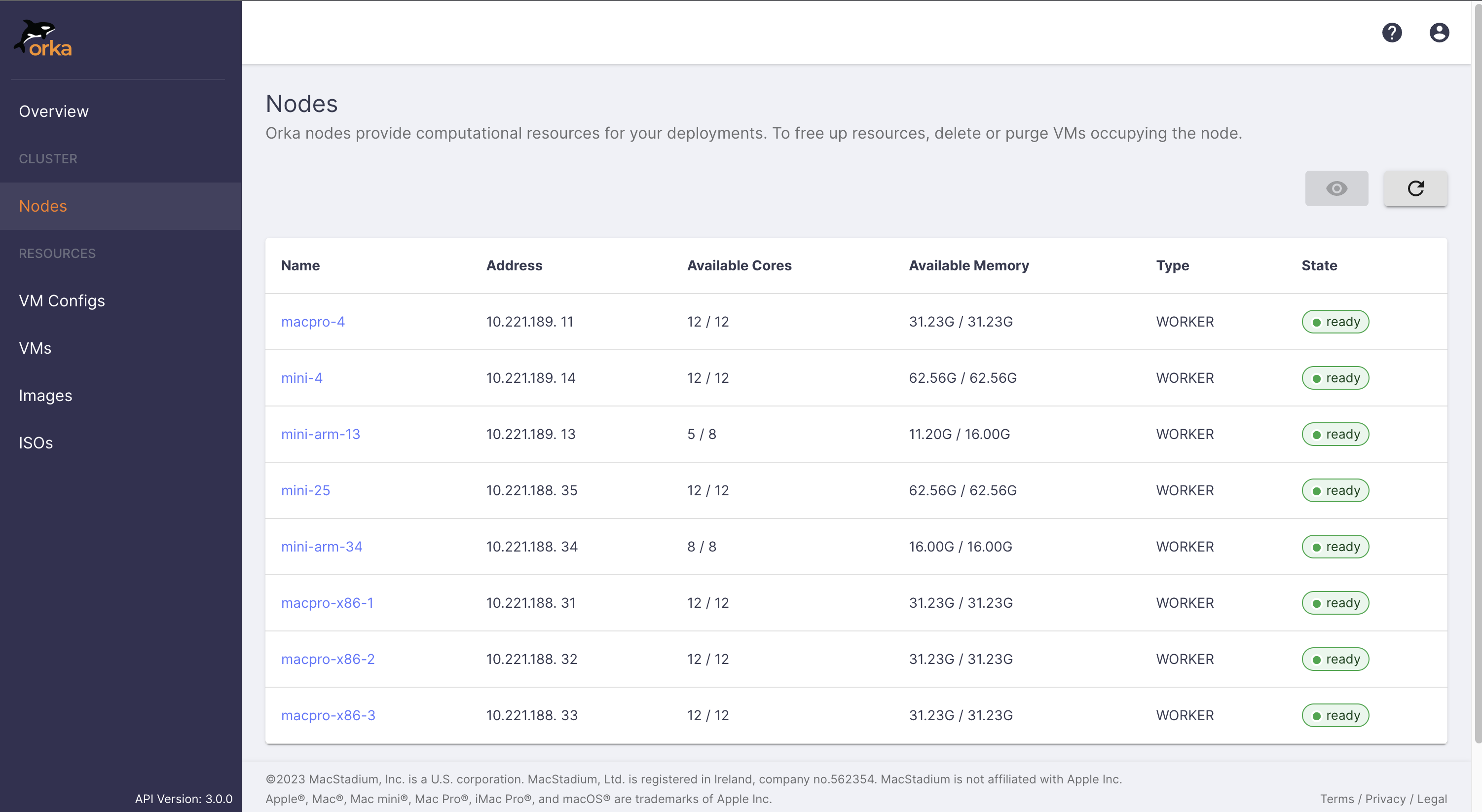
- In the sidebar, click Images.
You will likely see a ghcr.io/macstadium/orka-images/sequoia:latest item list. This is a fully installed and configured macOS Sonoma image with a 90GB disk size. It also has an admin user configured and SSH and Apple Screen Sharing access enabled.
Glossary: Image
A disk image that represents VM storage. Base images are bootable disk images that provide the OS, file system, and storage for your VM configs and VMs.
(Intel-only) Empty images provide added storage or serve as the base image during manual OS installs from ISO.
- In the sidebar, click VM Configs.
If this is your first time using Orka, you will get a blank screen.
- On the VM Configs page, click Create config and fill in the form:
- Name: Set any user-friendly name that will help you recognize the VM.
- Base image: Set to
ghcr.io/macstadium/orka-images/sequoia:latest. (Note that the settings in the dialog change based on the selected image type.) - CPU: Set to 3. This is the number of CPUs for the VM (Virtual Machine).
- vCPU: Set to 3. Unless the CPU is 3, it must be half of or the exact number of CPUs. This denotes if hyperthreading is enabled. For example, if the vCPU equals CPU, hyperthreading is enabled.
- Memory (G): Leave blank.This is the default setting.
When left blank, Orka automatically assigns the memory for your VMs.
When you provide a value for Memory, this overrides Orka and allocates the specified value to the VM (Virtual Machine).
VM name limitations
The name you specify under
VM Namemust meet the following requirements:
- Doesn't exceed 38 characters.
- Contains only lowercase Latin alphanumeric characters (0-9, a-z) and dashes (-).
- Begins and ends with an alphanumeric character.
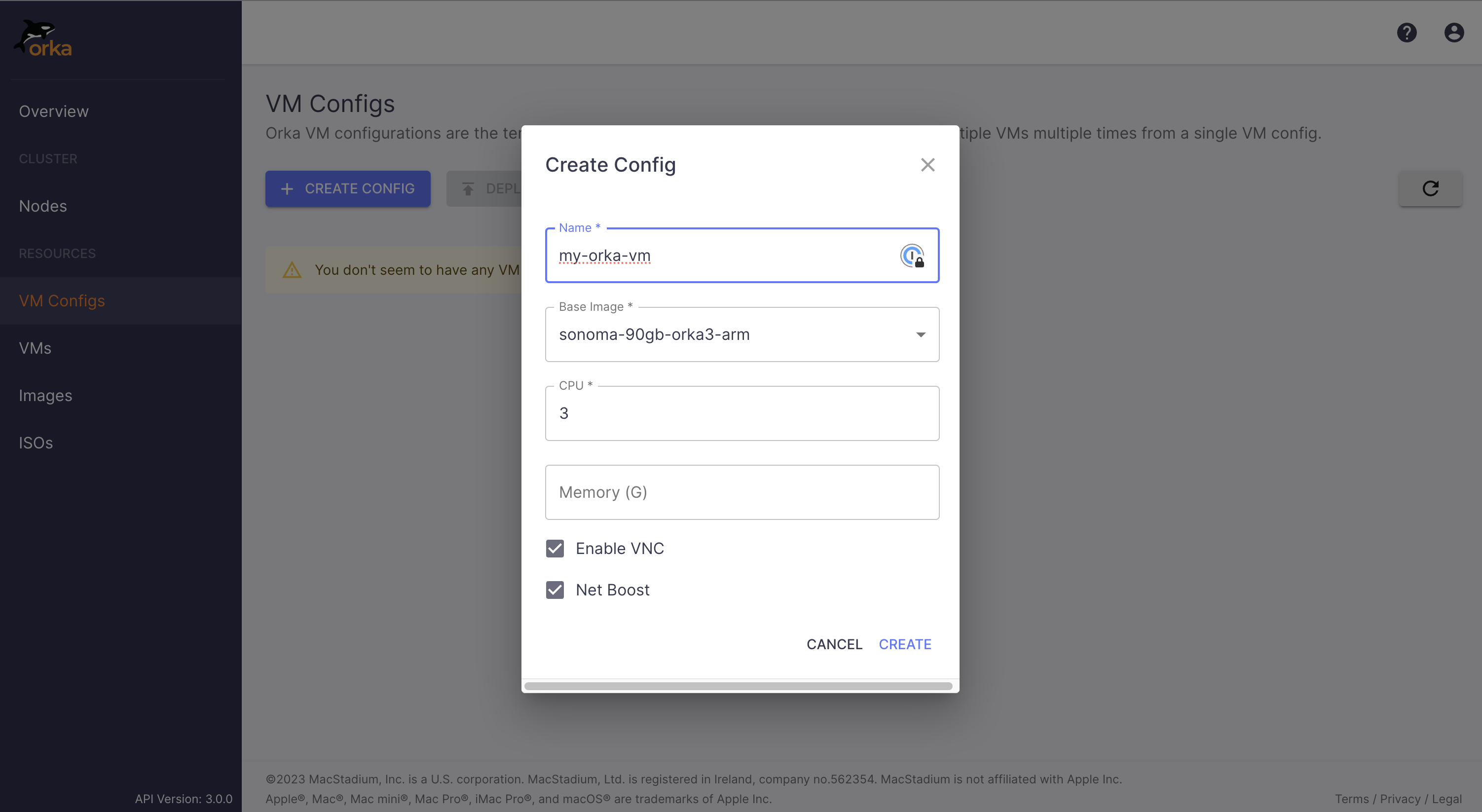
This creates a VM (Virtual Machine) config.
Glossary: VM config
A template for an Orka virtual machine. You can deploy multiple VM instances (VMs) from a single VM config.
- On the VM Configs page, select your newly created template and click Deploy config. Make sure that your template is selected and click Deploy.
Wait for the loading UI at the bottom of the dialog to complete. A success message should pop up at the top of the screen.
This deploys a VM (Virtual Machine) instance from your template.
Glossary: VM instance (VM)
A deployed instance of a VM config. VMs take up resources from your nodes and require a certain amount of CPU and RAM to run.
- Go to the VMs page. Now that you have deployed your first VM instance, you will see it in the list.

Note: this screen shows essential and detailed connection information about your VM (Virtual Machine).
Want to see more details?
If you're looking for more information about your VM, click its name in the list.
- Go to the Nodes page again. Did the number of available resources change?
5. Experience your VM instance
- Return to the VMs page and click the Connection button for your VM.
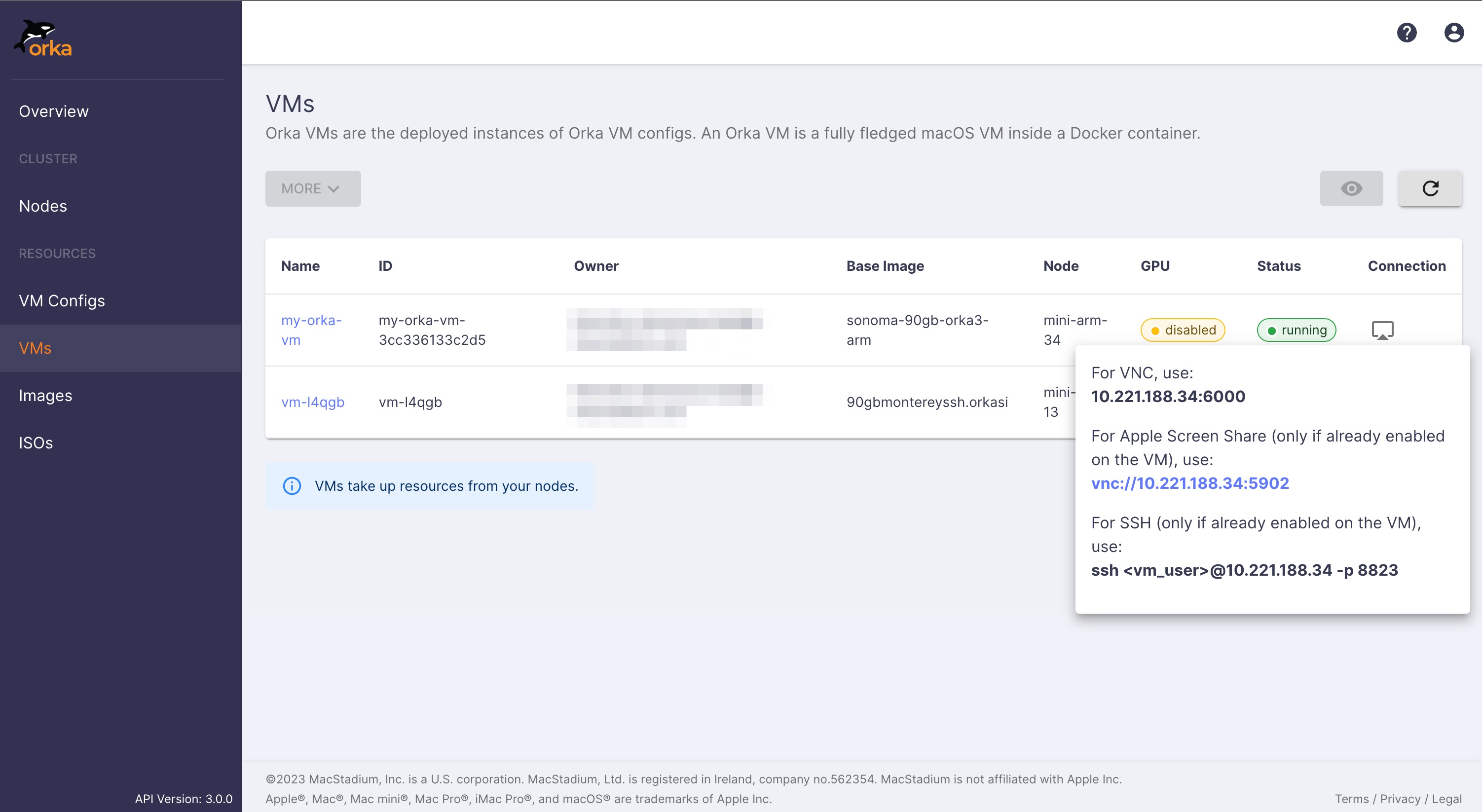
- Launch Apple Screen Sharing on your local machine (In Finder, press
Cmd+K). In the Connect to Server dialog, paste the information from the pop-up. (vnc://10.221.189.13:5903in the example above).
Not working on macOS?
This step works only on macOS. If you're working on a Linux or Windows machine instead, launch your preferred VNC client and connect to
<VM-IP>:<VNC-port>(10.10.10.4:6002in the example above).
One more thing to remember is that Screen Sharing must already be enabled within your macOS VM (Virtual Machine). This is usually not the case (especially on clean OS installs or after an ISO install (Intel Workloads Only)), and you must enable the setting yourself. This applied to SSH connectivity service as well.
The good news is that ghcr.io/macstadium/orka-images/sequoia:latest is already preconfigured for you, and you can enjoy out-of-the-box Screen Sharing and SSH connectivity.
Are you not using the
ghcr.io/macstadium/orka-images/sequoia:latestimage?If you're using another image as your starting point or if you are installing your OS from ISO (Intel Only), you will likely not have SSH or Screen Sharing enabled by default (even though the respective ports will be mapped by default). In this case, you need to connect to the VM via VNC. You can then enable SSH and Screen Sharing connectivity in the OS.
-
When prompted by Apple Screen Sharing, provide the credentials for the VM (
admin/admin). You will be prompted for the password again - when Apple connects to the VM. -
On the VM, launch System Preferences > Users & Groups. Select the Admin user and click Change password. Set the
Adminuser password to whatever works for you. -
(Optional) Launch the Terminal application and run the following command.
brew install orka-vm-tools
OR
brew upgrade orka-vm-tools
This action ensures that your VM (Virtual Machine) is running the latest version of the Orka VM Tools. This collection of services lets Orka manage the guest operating system on Apple silicon-based VMs (Virtual Machines) more efficiently and enables vital features, such as shared VM storage.
If your cluster is not running the latest Orka version, download and install an Orka VM Tools that matches the version of your cluster.
- Always apply the latest OS updates and restart the VM.
6. Create a new base image
Changing the configuration or the file system of a running VM (Virtual Machine) does not affect its base image. As soon as you delete the VM (Virtual Machine), your changes will be lost; in other words, they are ephemeral, and you will need to recreate them manually on other VMs (Virtual Machines).
You can save the changes as a new image to create changes that stick and appear on future deployments.
Glossary: Save changes
Savecreates a new base image from the current state of the respective VM instance. To use it, you need to create a new VM config that references the new base image.This operation restarts the VM.
- Return to the Web UI. On the VMs page, select your VM. Select More > Save as new image.
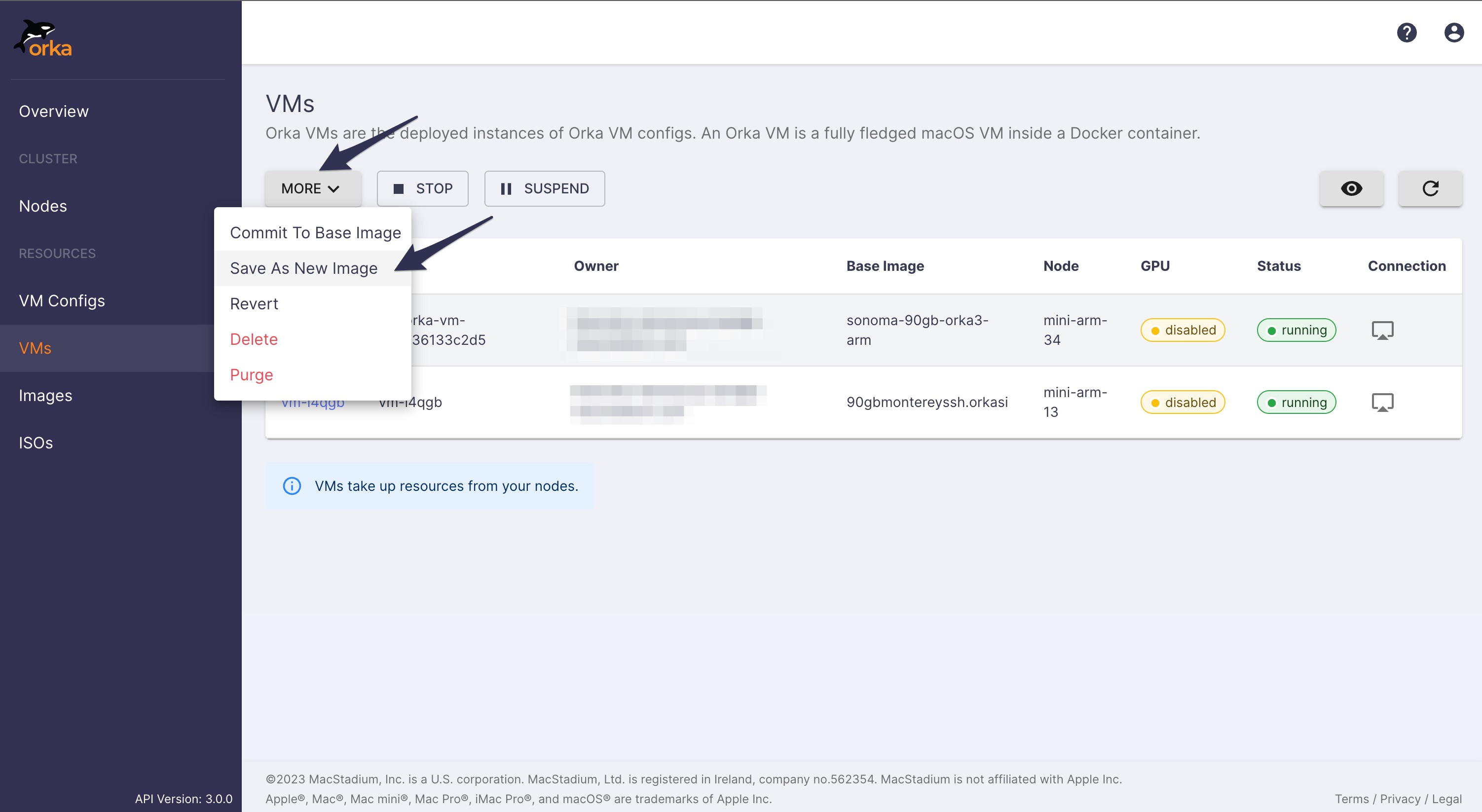
- Provide a name for the new image and click Save.
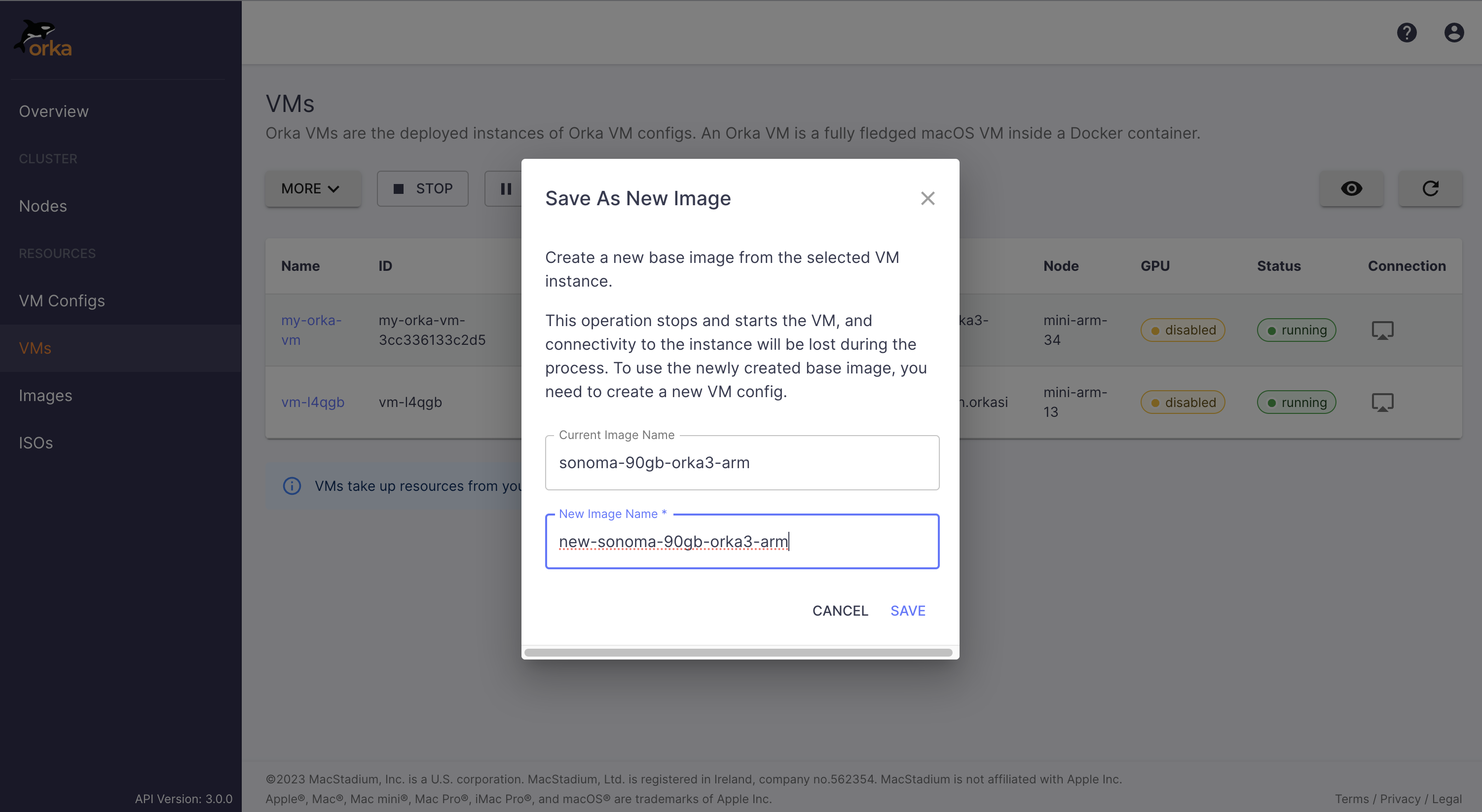
Wait for the operation to complete. It might take a while. There is no progress indicator, but the operation runs in the background. When the operation completes, the dialog closes, and a success notification appears.
- After the operation completes, go to the Images page. Did your new image appear there?
TIP
To use your newly created image, you need to create a new VM config.
7. Time to say goodbye
This section is optional.
When your VM configs and instances have served their purpose, you can remove them.
Glossary: Delete VM
This operation removes the specified instance(s). Delete always preserves the original VM config and you can deploy new VM instances from it.
- On the VMs page, select your VM. Select More > Delete. When prompted, confirm that you want to delete the VM.
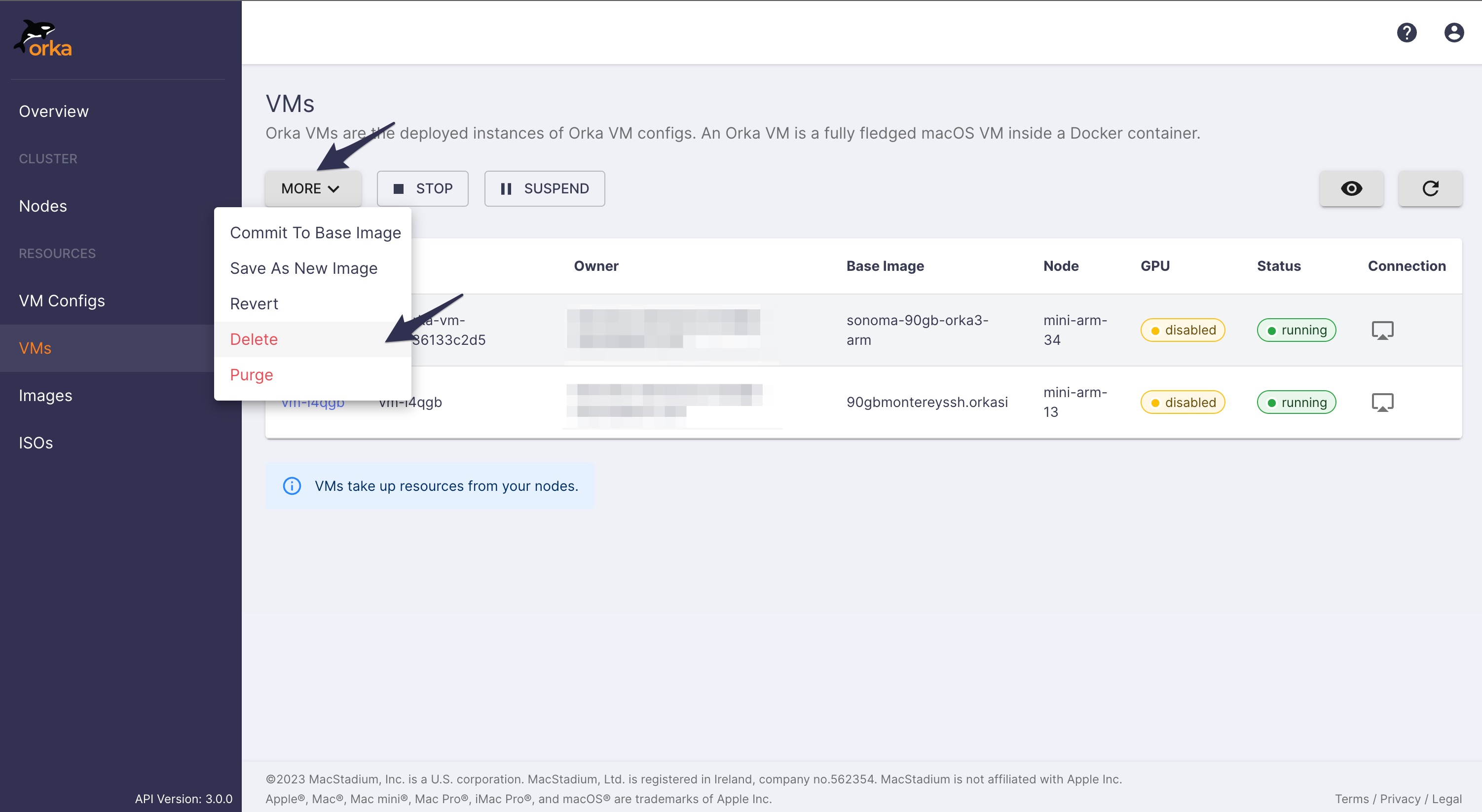
When the page refreshes, you should not see any more VM instances. Your VM config is still available on the VM Configs page, and you can deploy new instances from it.
Note that the changes you made to your deleted VM instance will not be present on newly deployed instances.
What's next
You're ready to explore the Orka UI on your own. You might find the following resources helpful:
- If you're looking for more advanced features, see CLI Quick Start and API Quick Start.
- Explore Orka Docs for more advanced tasks and tutorials.
- Seek help from the Orka community in the MacStadium Community Slack.
- File a support ticket in the MacStadium portal.
- Is a feature missing? Please share your feedback with us by filing a ticket in the Customer Portal.
- If you want to tap into Kubernetes, see this page.
Updated 6 months ago
